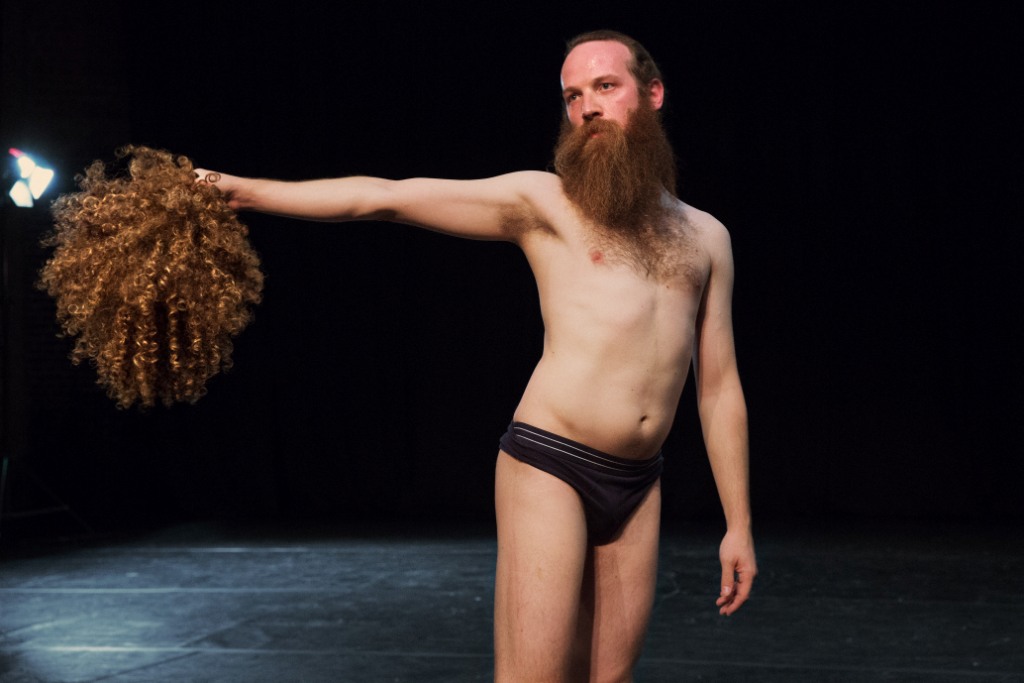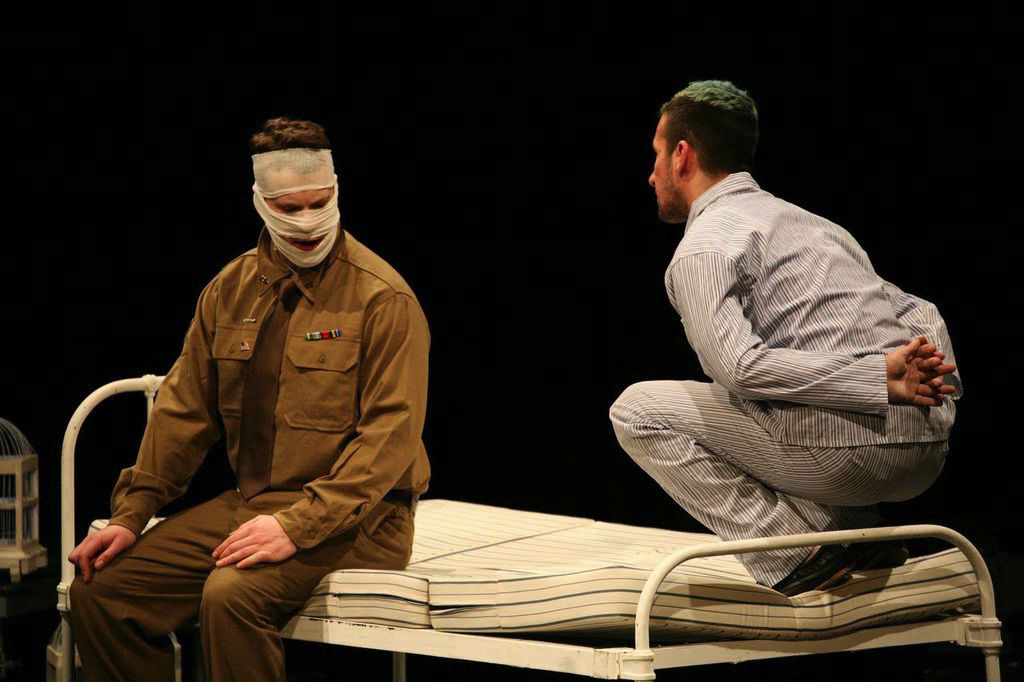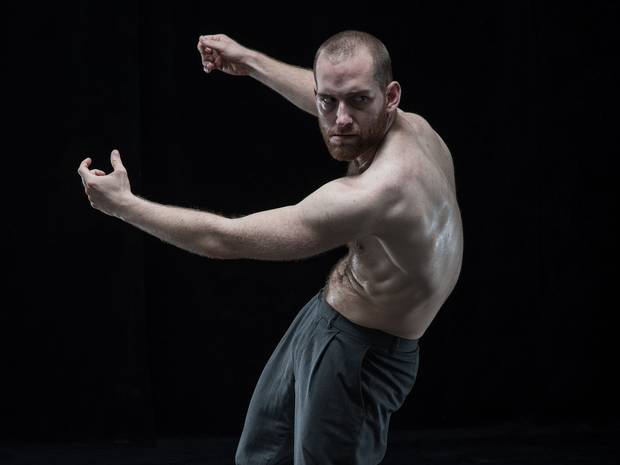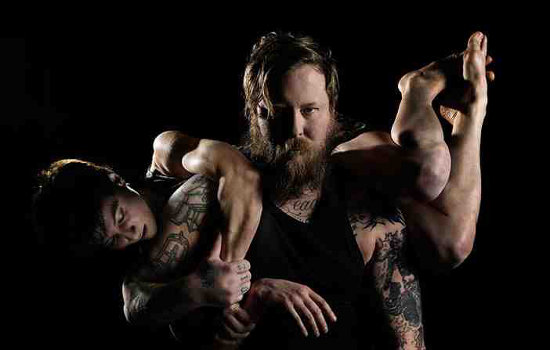What do you know about sex? How do you know it? Dorothy Max Prior sees two shows at Sick! festival that are presented as part of the Wellcome Collection Sexology Season – and joins in the ensuing post-show discussions
So You Can Feel: the opening show in Sick! Festival 2015. The house lights are still up. Pieter Ampe walks out onto a bare stage. He’s dressed in regular-guy jeans and a T-shirt, and he has a hipster beard and longish hair pulled back from his face. He stands. He eyes people up. He goes very close to a woman in the front row. He intercepts a latecomer and puts his arm around her, gently. She laughs and we laugh with her, with him. His gestures and actions are all pretty ‘normal’ – by which I mean he doesn’t do anything that you would consider out of the range of regular-guy behaviour – although of course he is onstage, so everything is framed, everything feels important, relevant. He exits, almost, and re-enters the space in a different mode. Now there’s music, and a bar stool. He gets up even closer to the woman in the front row. He takes off his T-shirt and flexes his muscles. He changes costume, many times. He clambers over us. He goes from regular-guy to wacky way-out guy in a wild Afro wig bouncing around with a beach ball, to parody gay-club cruiser bumping and grinding in a shiny black nylon mankini, to see-through fishnet-clad go-go dancer, rotating his hips provocatively and shouldering a leg with an ease that would challenge any good Can Can dancer. Ultimately he’s naked – yet still ’dressed’, in body paint that seems to transform the human flesh into a statue, an object d’art to be gazed at and admired. At what point, if any, his presence seems to be asking, are we looking at adornment and gestures and body movements that are beyond the norm for a male body? Is a hair scrunchie OK? A wig? A catsuit? Can a man circle his hips without being considered ‘womanly’? What in any case do we mean by ‘manly’ or ‘womanly’?
Although this is not a dance piece, Pieter Ampe’s beautifully structured and delivered performance is that of a dancer and choreographer – he has the ease and control of his body that comes from years of physical training. There is also a lovely relationship with music in the piece, which seems to tell a parallel coming-of-age story – from the exuberant boyishness of Whole Lotta Shakin’ through the emotive and embracing Frankie Goes to Hollywood classic The Power of Love to the edgy, ‘been there done that’ tone of Nina Simone’s live Stars/Feelings medley
- Pieter Ampe: So You Can Feel
In his play with receiving the gaze and framing himself as a moving sculpture, and in his use of props and costume, he reminds me a lot of legendary female performance artist La Ribot. In the post-show discussion, there is debate about humour – specifically, whether a woman performing the same gestures and movements would raise a laugh (as Ampe did) with a similar bump-and-grind and leg-splaying – and whether we are laughing to cover up discomfort. This last point is put to us by guest speaker Eric Anderson (Professor of Sport, Masculinities and Sexualities at the University of Winchester). This suggestion is refuted strongly by many members of the audience – there are few if any here who would feel discomfort at the sight of a man in a wig and a fishnet catsuit, even one gyrating his hips provocatively. And many of us also feel that many women working within New Dance and Performance Art have successful reclaimed the gestures and actions familiar from the products of the sex industry, and made them their own: from Annie Sprinkle and Coum Transmissions through to The Two Wrongies, Rosana Cade, and GETINTHEBACKOFTHEVAN. It looks as if an interesting discussion might be brewing on what we call ‘feminine’ dress and why physical actions are viewed as feminine or masculine. There’s a brief discussion of changing mores in Western society (18th century men in powdered wigs and heels are cited, as is the long-haired liberation of men in the 1960s and 70s that preceded the neo-reactionism of the 1980s onwards). I’m all poised to put forward the suggestion that some movements (particularly circular hip- or pelvic-based ones) are deemed ‘feminine’ because of their longterm association with biologically female experiences of fertility and childbirth – so called ‘belly dancing’, forerunner of the stripper’s womanly gyrations, having developed (many sources claim) in the all-female harems, as a means of easing the pains of menstruation and labour. But sadly, the discussion veers away from this interesting subject and into a defence of Professor Anderson’s key beliefs about contemporary male image and behaviour.
Although suggesting earlier that we might feel discomfort with images of the male body that challenge the norm for men, Anderson argues that things are very different nowadays for young heterosexual men – claiming that his extensive research shows that ’straight’ 17-year-olds are happy (for example) to wear pink and to share a bed with a male friend who isn’t a sexual partner. Although no-one is disputing his findings, within the demographic he has chosen to work, this American sociologist’s rather romantic view of British youth is challenged by numerous audience members. Some of us raise the question of rising trends for teenagers within the Islamic community to adopt conservative views about sexuality – with young women veiling themselves in growing numbers, and both sexes citing religious texts that supposedly support the subordination of women and the extermination of gay men. Anderson’s reply to this is astonishing: he says that it is of no interest because Britain is ’93% white’ and that he is not willing to go into Muslim communities, because as a gay man he would be unsafe. When BBC journalist Melita Dennett challenges Anderson’s hunky-dory view of teenage tolerance, citing the use of the word ‘gay’ as an insult, even in the liberal oasis that is Brighton in 2015, she is told that she has ‘an attitude’.
Luckily the chair, performance artist Boogalu Stu (dressed very fetchingly in a peach feather onesie with matching nylon quiff), manages to get the focus back on Pieter Ampe and his work. Much of the purpose of this, his first solo work, was to playfully explore his own liberation (as a self-defined heterosexual man) from restrictions of how the 21st century male body could look and move. Ampe talks of a desire to expose and move away from shame. To shame ‘shame’, you could say. He suggests that of all the things that a human being could be ashamed of, it’s a shame that physicality and sexuality are such a source of shame.
Shame – and the shaming of shame – is also right at the heart of Christopher Green’s latest work, Prurience, which is presented at Sick! as a work-in-progress (although this isn’t made clear in the publicity, it is flagged up in the discussion after the show).
The theatrical conceit is that artist and audience are members of a self-help group for self-confessed porn addicts. The Brighton showing is in Fabrica, an art gallery set in a deconsecrated church, which feels appropriate. As we come in, we are asked to make ourselves a name-tag, and to write down our expectations, hopes or fears for tonight on a slip of paper placed in a bowl. There’s a circle of chairs, and a trestle table at the rear of the space with tea and coffee. Christopher Green introduces himself as ‘Jack’, and gets the ball rolling by inviting members of the group to take and read out some of the Expectations papers. ‘I’ve kicked the coke and the cake – now it’s just the cock’ is one. ‘Great expectations!’ is another. Others are a little more prosaic: ‘I’m keeping an open mind’ or ‘No expectations.’ As the evening progresses, we are drawn into confessional mode by our uber-Californian self-help guru Jack, who insists on tolerance and respect for others with that kind of tense and slightly edgy tone so familiar from counselling and support groups. No-one is forced to participate – it’s fine to just observe and listen. The stories that emerge are harrowing, funny, believable, incredible. A woman who likes watching extreme gay male porn. A 20-year-old man who has seen so much that he now suffers from erectile dysfunction. A middle-aged male therapist who is sick of seeing his pleasure described as a problem. The beauty of the structure of the piece is that, as with porn itself, it is really hard to tell the difference between reality and fabrication. Which stories belong to the teller, and which don’t? Which of us (if any) are plants? Who’s acting and who’s ‘acting as if’. In both porn and self-help groups, role play is important. Some words seem to come from the heart, spontaneously, and some are pre-prepared statements or commitments, read out at Jack’s request. ‘No more wanking in the office disabled toilet trying not to get spunk on my iPhone’ is one. Everything is OK, except when it’s not OK – we’re here to bear witness, not to judge or intervene, and Jack helps us to understand and obey the ground-rules. Thankfully, no one mentions 50 Shades of Grey. There’s poetry, and a group song, and a break for more tea and coffee. And after the break, a build into ever-more intense interaction, with lots of huffing and puffing, until a climax is reached…
When the show ends, the bar opens – and filmmaker Toby Amies chairs a fertile and invigorating discussion. The sexology expert on-hand tonight is Clarissa Smith (Professor of Sexual Cultures, University of Sunderland) – who is thankfully far less volatile than Eric Anderson, calmly presenting a good case for tolerance and acceptance, pouring cold water on the fever about the dangers of pornography. She cautions against the medicalisation of porn consumption – as an example, she seriously doubts the evidence on porn addiction resulting in erectile dysfunction in young males. Christopher Green talks about his desire to create a show that expresses as many different viewpoints as possible, rather than a polemic piece that takes sides. He talks with great concern about the commodification of both porn and the ‘cure’ for porn addiction: we are in a society that sells us the notion of addiction (porn, drugs, fags, food), tells us we have a problem, and sells us the solution. Therapy itself has become codified; has lost its sense of play – hence Green’s creation of prurience.org (with its charismatic founder, DVDs, and branded T-shirts), and the unsettling Jack character, a perfect parody of the sort of groups and group leaders that invade every aspect of our ever-more addicted lives. A few questions Christopher Green thinks we should all ask ourselves: Who are we giving the power to? Where are we getting our facts? Who is driving the moral panic?
Porn, says Professor Clarissa Smith, is neither good nor bad. It just is. Perhaps it goes without saying – but I still feel it needs to said – that there are limits to libertarianism. When talking about porn, we need to be clear that we are indeed discussing pornography – adult erotica, made by and for consenting adults – not images of child abuse. There is a growing awareness of the need to describe these images as what they are, rather than using the term ‘child porn’. Professor Smith is quick to clarify that what we are discussing excludes the viewing of images of child abuse, which is rightly illegal.
Both of these shows are presented at Sick! with the support of The Wellcome Collection, as part of its Sexology Season. Other shows and events in the festival similarly supported include What Tammy Needs To Know About Getting Old And Having Sex, in which Tammy WhyNot (the girl who put the ‘cunt’ into ‘country’) – aka performance artist Lois Weaver of Split Britches – collaborates with older people in Brighton, drawing on their personal stories of over-age sex; Brian Lobel’s Sex, Cancer & Cocktails, an ‘in-home conversation about doing it during treatment’; and Sexual Violence: Male Problem/Male Solution? a debate that asks how masculine identity in the 21st century can continue to allow the horrific level of abuse still perpetrated against women and girls. The opening event of the Brighton leg of the Sick! festival (which also runs in Manchester) was not a show but a debate, called Sexual Transactions, and the programme also includes a film called The Unspeakable Crime: Rape, and a showing of the internationally acclaimed verbatim theatre show about the horrific Delhi bus rape and murder of the girl they called Nirbhaya. It is evident from the high profile within the programme, and sheer amount of events on the subject, that issues around sexuality – male sexuality, in particular, are high on the agenda.
This is an interesting move for Sick! which is now in its third year, and establishing itself as a major fixture on the UK festival calendar. In the first two years, the programme was focused on exploring attitudes towards health, illness, and disability – and in particular, providing a platform for disabled artists making work about their bodies and their selves. In 2015, the interest is broader, becoming a festival ‘that confronts the challenges of life and death’ – challenges that ‘are sometimes rooted in bodies and minds that fail us, sometimes in the complexities of living in an imperfect society… bearing witness to the realities of our lives and shining a light on urgent issues that remain taboo or misunderstood’. A pretty broad sweep – which along the way takes in the brilliant Chop Theatre production How to Disappear Completely, in which lighting designer and filmmaker Itai Erdal delivers a reflection on his mother’s life refracted through the lens of hours of footage he has taken of her (reviewed at the Edinburgh Fringe 2014, where it was shortlisted for a Total Theatre Award); and Sue Mac Laine’s new show Can I Start Again Please? in which her two lives, as theatre-maker and BSL interpreter for other people’s theatre, become one in a piece described as a ‘duet and duel’ in which two performers (the writer herself and Nadia Nadarajah) used signed and spoken language in a ‘linguistic challenge to represent traumatic experience, in particular that of childhood sexual violence’.
In the festival programme notes on Can I Start Again? it is described as a piece that is ‘both personal and political’. There has been much recent debate in the wider world about the need for politics to move away from the personal and back into collective organisation and action – to be less about ‘me’ and more about ‘us’. Yet whilst we still have a world in which a man can be thrown from a tower for no other reason than he is known to be homosexual; or a woman can have acid thrown in her face for having ‘dishnoured’ her family by making her own choice of husband; or a child can be groomed by a gang of men, who are not prosecuted for years because she is deemed at age 13 to be a ‘slut’ and not worth the police or council’s consideration – then the personal and political cannot be separated. Yes, we must act collectively –voting, campaigning, standing up the rights of others, demanding an end to the structures of power (political, financial, religious) that are used as tools of oppression. But the telling of personal stories, and the bearing witness to those stories, is a crucial part of the process of liberation and progression.
Dorothy Max Prior saw the UK premiere of Pieter Ampe/Campo’s So You Can Feel at The Old Market, Hove on 5 March 2015, and Christopher Green’s Prurience at Fabrica, Brighton on 6 March 2015. Both were presented at Sick! Festival with the support of The Wellcome Collection as part of the Sexology Season.
www.wellcomecollection.org/sexologyseason








